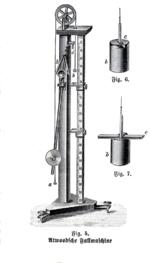|
Atwood machine The Atwood machine (or Atwood's machine) was invented in 1784 by the English mathematician George Atwood as a laboratory experiment to verify the mechanical laws of motion with constant acceleration. Atwood's machine is a common classroom demonstration used to illustrate principles of classical mechanics. The ideal Atwood machine consists of two objects of mass m1 and m2, connected by an inextensible massless string over an ideal massless pulley.[1] Both masses experience uniform acceleration. When m1 = m2, the machine is in neutral equilibrium regardless of the position of the weights. Equation for constant acceleration An equation for the acceleration can be derived by analyzing forces. Assuming a massless, inextensible string and an ideal massless pulley, the only forces to consider are: tension force (T), and the weight of the two masses (W1 and W2). To find an acceleration, consider the forces affecting each individual mass. Using Newton's second law (with a sign convention of ) derive a system of equations for the acceleration (a). As a sign convention, assume that a is positive when downward for and upward for . Weight of and is simply and respectively. Forces affecting m1: Forces affecting m2: and adding the two previous equations yields and the concluding formula for acceleration The Atwood machine is sometimes used to illustrate the Lagrangian method of deriving equations of motion.[2] See also
Notes
External linksWikimedia Commons has media related to Atwood's machine.
|
Portal di Ensiklopedia Dunia








